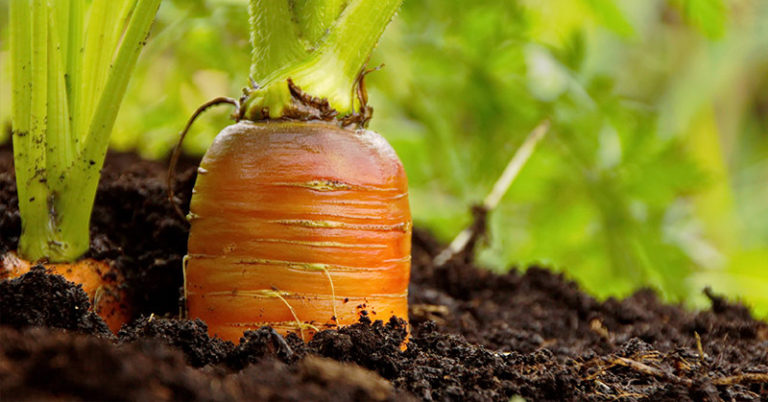When people plant their first vegetable gardens, they tend to start with herbs, tomatoes, and similarly easy crops. Since carrots grow below ground, they seem more complicated to grow, but this is not the case. With proper guidance, anyone could be growing a crop of delicious carrots without fuss.
For a successful harvest, check out this secret tip that ensures delicious, bright, and crunchy carrots every time.
Introduction to Carrots and Their Varieties
Carrots are root vegetables, which means they grow in the earth with only their leafy green tops visible. The most well-known varieties are brilliant orange colors, but others look purple and pale yellow.
Here are some varieties you can try:
- Nantes: Nantes carrots are named after the French city where they do exceptionally well. They’ve also become popular for home gardeners because their growth cycle is short and their taste is delicious.
- Danvers: These carrots are what you think of what you imagine the perfect carrot: about eight inches long, thick, and bright reddish-orange.
- Mini: Mini carrots are ideal for container gardens and they are often served with their greens still attached. They add a perfect touch of delicious ruggedness to any meal.
- Chantenay: These carrots work well with rockier soils and can grow to about seven inches long. Therefore, they can thrive in gardens or large containers. Keep in mind that if they grow too long, they will lose their sweet flavor.
- Imperator: These are the standard carrots most people buy from grocery stores, thick, long, and sweet.
Read More: 10 Vegetables That Tolerate Partial Sun And Shade
How To Grow Carrots
Carrots thrive in cool weather so they should be planted early in the spring before the summer heat comes. Don’t worry about a false spring since many types of carrots can survive some frost. Plant them in a sunny area. Full sunlight is best but they can also grow in partial sunlight.
The soil should generally be loose, loamy, and rock-free. Any kind of debris in the earth can force the carrots to mold into strange shapes. Additionally, keep the soil as neutral pH as possible.
No matter if you choose to raise them in the ground, in containers, or a raised bed, the method of planting carrots is the same. Scatter the seeds and hide them under a thin amount of soil. The carrots should be given about an inch or two of space to grow — a little like spacing out cookie dough on a pan before baking them.
Carrots require plenty of water to keep the soil moist until the tops of greenery emerge.
The Best Carrot Planting Hack
Here’s the hardest part: ensuring the carrots sprout. They need constant moisture in order to do so and they could be a little temperamental.
Fortunately, our resident farmer, Thomas, shared a secret for growing carrots from his grandfather.
After you seed the row of soil and water them, place a 1″ x 4″ board over them. You read that right; place the board over the soil with the seeds. Lift it daily to check the seeds and water them. Once they begin to sprout, prop up the board with bricks on either side of the row. This way, the soil is still shaded but the sprouts have room to grow. Once the seedlings can reach the board, you can remove it.
This hack will keep the seeds moist and shaded as they sprout — the most vital part of the process.
Read More: 12 Vegetables You Can Grow All Winter
More About Planting Carrots
Avoiding Pests
Before you seed, ensure you are rotating your crops. Planting carrots in the same place makes them more susceptible to pests, particularly nematodes, and cavity spot — a kind of fungal infection that makes the crops inedible.
Additionally, till the soil, if you have had issues with wireworms before you plant. Once the carrots are growing, there’s little to do to fight a wireworm infestation if you want to keep the crops.
Harvesting the Carrot Crop
Harvest depends on the type of carrot, but it should be anywhere between 50 to over 75 days. Baby carrots are pulled when they are still small, but regular-sized carrots are usually about a half of an inch.
Here’s how you know if the carrots are ripe for the pulling: Feel the base of the vegetable, just beyond the greens. If a carrot is ready, it will have “shoulders” about three-quarters of an inch.
Loosen the soil with a fork or a similar tool before pulling the carrots. You don’t want to disconnect the stem from a stubborn vegetable.
Carrots can become soft when they are left in storage for too long. They are best consumed fresh so don’t harvest more carrots than you can eat in a short amount of time. Unlike lettuce that turns bitter or tomatoes that become overripe, carrots can be left in the garden for weeks with no unsavory effects on them. Just be sure that the garden is weed-free, the soil is well-balanced, and the weather is still warm.
Keep Reading: How To Store Carrots For 5+ Months




